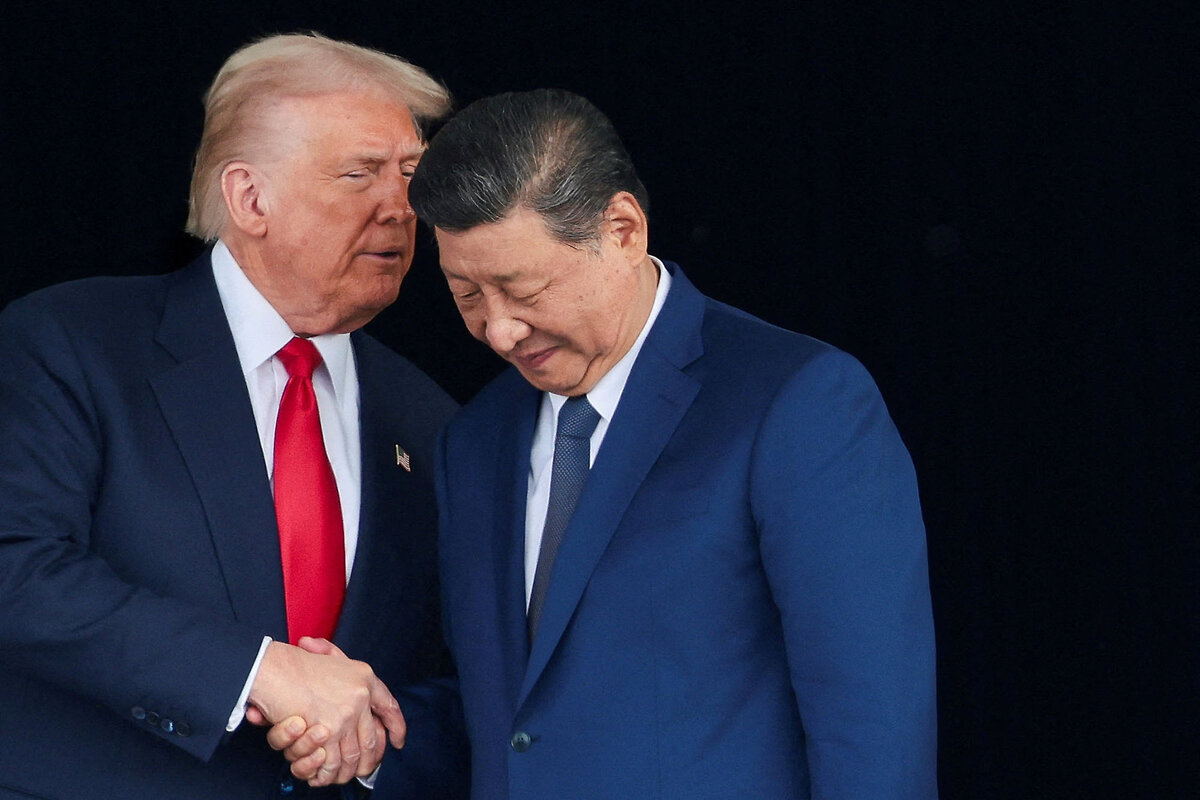Copyright csmonitor

Xi Jinping struck a confident tone as he and U.S. President Donald Trump hammered out an apparent truce in their six-month trade war on Thursday – in which the Chinese leader has matched Mr. Trump blow for blow. They instructed their teams to finalize “soon” a deal aimed at stabilizing commerce and halting a dangerous escalation of the trade conflict that has threatened to roil the world’s two biggest economies. “The two sides... must not fall into a vicious cycle of mutual retaliation,” Mr. Xi told Mr. Trump, according to a summary of his remarks provided by China’s Foreign Ministry. Beijing offered few details following the two-hour meeting in Busan, South Korea, the first face-to-face talks between the two leaders since 2019. But Mr. Trump told reporters aboard Air Force One afterward that both sides gave ground in key areas. Beijing agreed to suspend restrictions on its global exports of rare earths, of which 90% are processed in China, he said. These are critical minerals used for everything from jet engines to electric vehicles. Mr. Trump said he agreed to halve “immediately” the United States’ 20% fentanyl-related tariff on Chinese exports after Mr. Xi pledged to crack down “very hard” on illicit exports to the U.S. of fentanyl precursors. Later Thursday in Washington, Treasury Secretary Scott Bessent said the two sides could sign a trade agreement as early as next week. He said China agreed to buy 25 million metric tons of American soybeans annually as part of the deal. The tariff cut still leaves Washington with a roughly 45% average tariff rate on imports from China, compared with China’s 32% tariff on imports from the U.S. The tariffs have led American imports from China to plunge from $42 billion in January to $19 billion in June, before rebounding slightly to $26 billion in July, according to a Cathay Bank report. Yet China’s economy has weathered the U.S. pressure, Mr. Xi told Mr. Trump, noting that gross domestic product in his country grown by a robust 5.2%, while its overall trade in goods increased by 4% during the first three quarters of this year. Xi displays confidence “We have the confidence and capability to navigate all kinds of risks,” Mr. Xi said. The latest trade instability has given both sides some “insights,” he said, possibly hinting that Washington had underestimated China’s resilience when it launched the trade war in April. Though China is broadly more reliant on the U.S. market for exports, Beijing has skillfully leveraged its strengths in key trade sectors, halting imports of American soybeans, for example, and wielding supply-chain dominance over goods such as rare earth magnets. China’s sweeping move this month to tighten its grip on the rare earth industry with a global licensing requirement showcased Beijing’s chokehold. “That really felt like Xi was shifting from defense to offense,” says Jonathan Czin, a fellow in the John L. Thornton China Center at the Brookings Institution in Washington. Mr. Xi, by standing firm and hitting back at each U.S. trade barrier – repeatedly leading Mr. Trump to back down – forced a painful reckoning, experts say. It only made sense for both sides to try to de-escalate. “Both leaders saw what rapid and full decoupling could look like in April, and they both said – ‘I don’t think so,’” says Christopher Johnson, the chief executive of China Strategies Group, a political risk consultancy, and a former top China analyst at the CIA. “When you look over that precipice, it is not a good look,” he said during an Asia Society Policy Institute webinar. The path to stronger cooperation? Indeed, it was Beijing’s ability to fight its way to a stalemate with Washington that paved the way for meaningful negotiations, potentially leading to a broader reset of the U.S.-China relationship. Chinese leaders went into Thursday’s meeting with “an unprecedented sense of confidence and empowerment,” says Yun Sun, director of the China Program at the Stimson Center. While they expect the long-term strategic rivalry with the U.S. to continue, they view Mr. Trump as potentially their last best hope for backing cooperation over competition, China experts say. They believe that, unlike China hawks in the Republican and Democratic political establishments, “Trump has defined China as a country to work with,” says Ms. Sun. Reflecting this, Mr. Xi made an unprecedentedly positive reference to Mr. Trump’s MAGA slogan. “China’s development goes hand-in-hand with your vision to Make America Great Again,” Mr. Xi said. “China and the United States should be partners and friends.” In a sign that they expect their dialogue to continue, the two leaders exchanged invitations for official visits to their respective countries. Mr. Trump said he will visit China in April, with Mr. Xi coming to the U.S. later next year. Mr. Trump said the two leaders had a wide-ranging discussion that covered other pressing international issues, including a lengthy exchange on the war in Ukraine. “We are going to work together to try and get the war with Russia and Ukraine solved,” he said. The contentious topic of Taiwan, the self-governing island off China’s coast over which Beijing claims sovereignty, “never came up,” Mr. Trump said. Overall, Mr. Trump was effusive about the meeting, calling it “a great success.” “For two very large, powerful countries – that is the way we should get along,” he said.



